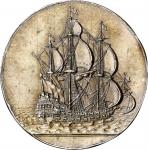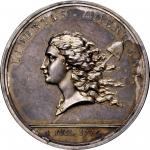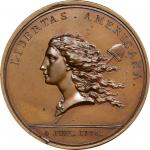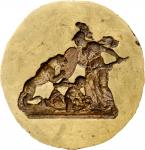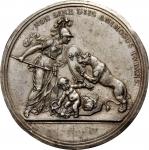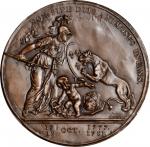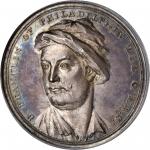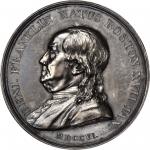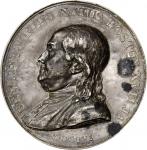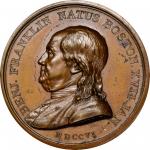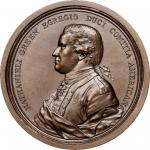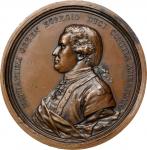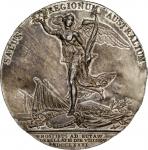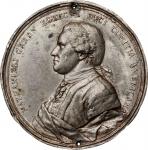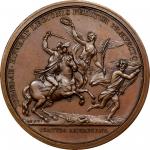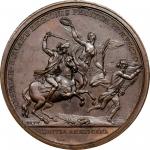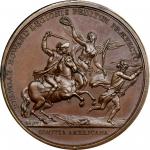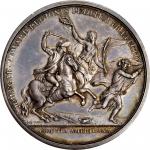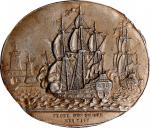1779 Flote du Conte Destain trial. Betts-unlisted, Dupre No. 15, <em>Augustin Dupre</em> (Trogan & Sorel, Musee Carnavalet) 9. White metal. Workshop of Augustin Dupre. 40.7 x 34.7 mm, oval. 156.6 grains. 0.6 - 1.1 mm thick. Choice About Uncirculated.Backed with later white paper inscribed "1779" in pencil in the hand of Narcisse Dupre. Glossy, sharp, and beautiful, a perfectly made little "epreuve detain" or tin proof, thinly coated at the time of its production to give it a more coppery appearance. Intact and perfectly preserved, with just a few trivial surface scratches in the left field.<p>This trial, presumably intended as a reverse, depicts Grenadas Fort George at left - complete with that forts distinctive archways - and shows dEstaings flagship <em>Languedoc</em> at center with smoke billowing from her guns as they bombard the fort. At right, two more distant ships offer their own cannonades, all in the brilliant detail that Dupre rendered in larger module on the John Paul Jones medal he accomplished later. The only visible inscription is in the exergue, identifying the scene: FLOTE DU CONTE DESTAIN. <p>The Musee Carnavalet holds the only other example of this effort known, a nearly identical oval cliche whose quality is not quite as good as this one, as that piece displays a substantial crack at its upper left. On p.132 of Rosine Trogan and Philippe Sorels 2000 catalog of the Dupre collection of the Musee Carnavalet, they describe their piece as follows:<em> "Ce projet demedaille relative a la brilliante campagne americaine de ladmiral dEstaing de 1778-1779 fait partie de lensemble doevures que Dupre executa au moment delindependence des Etas-Unis, la plupart faisant a des commandes americaines. Cet essai semble le seul connu." </em><p>In translation: "The medal project relating to the brilliant American campaign of Admiral dEstaing of 1778-1779 is part of the group of works that Dupre executed at the time of the independence of the United States, most of them of American commanders. This trial appears to be the only one known."<p>Why the medal was never struck is unknown. Perhaps it was undertaken while dEstaing was laying siege to Savannah and was less advisable once he returned to France injured. Perhaps this die was on his desk when David Humphreys came calling in 1785 and was delayed when the Comitia Americana project required his full attention. <p>We may never know, but authorities in the field have long seen this medal as something of a holy grail among Dupres medals of American interest. Leonard Forrers biography of Dupre in his <em>Biographical Dictionary of Medalists</em> quotes a June 1900 article by Andre Hallays in the <em>Revuede lArt</em>: "Augustin Dupre est lecreateur de la medaille moderne. ... Il est a la fois un portraitiste (<em>Franklin, Lavoisier, Louis XVIII</em>) et presque un paysagiste (<em>la Bataille de Cowpens</em><em>, la Flotte decomte dEstaing</em>)," calling him "the creator of the modern medal" who is "at times a portraitist, … and nearly a landscape architect," identifying this piece as one of his key works in the latter category. Charles Blancs 1870 lecture entitled "Notice Sur La Vieet Les Ouvrages DAugustin Dupre," translated by Len Augsburger in the May 2007 issue of <em>The MCA Advisory</em>, likewise mentions this enigmatic medal as evidence of his brilliance: "The flotilla of the count dEstaing [reference is made to a medal commemorating dEstaings victory in naval engagements against the English] that spreads out its sails in a composition with not more than a thickness of 2mm so that the juxtaposed vessels produce the illusion of distance, and the ocean, depicted by some waves, portrays to us the idea of depth."<p>The authority that means the most to us is one your consignor and your cataloger knew well, the late Richard Margolis, unquestionably Americas foremost expert on the works of Augustin Dupre and his contemporaries. In his August 2007 review of Adams and Bentleys <em>Comitia Americana</em>, Margolis took issue with the inclusion of the 1777 B. Franklin of Philadelphia medal and suggested another more closely linked to the Comitia Americans series. "There is a piece which has a solid claim for inclusion, but does not appear, "Margolis wrote.<p><em>This is a rather obscure trial piece in white metal, unsigned but reliably credited to Augustin Dupre, commemorating the Fleet of Count dEstaing, which took part in the unsuccessful siege of Savannah. The example in the Musee Carnavalet is described and illustrated on p. 132 of Augustin Dupre (1748-1833) Graveur General des Monnaies de France; Collections du Musee Carnavalet, by Rosalie Trogan and Philippe Sorel. It also appears on the descriptive list of Dupres works, now in the Paris Mint, which was prepared by his son, Narcisse Dupre (referred to by Trogan and Sorel on their p. 90).…</em><p>Of the brilliance of this particular naval campaign there may be considerable question, and whether this piece originated with an idea by Dupre himself, or was suggested to him is not known, but by commemorating an important French fleet action in the War of Independence and its prominent commander, I think that Augustin Dupres little trial piece qualifies for inclusion in a study of the Comitia Americana medals.<p>Margolis did not know in 2007 that this exact specimen still lay hidden away in Dupres own collection. He only knew of the example today in The Musee Carnavalet, which Narcisse Dupre described and listed as No. 15 on his <em>ListesdOeuvres DAugustin Dupre, Conservees aux Archives de la Monnaie de Paris.</em>He dated it to 1779 (the date inscribed on the back, which refers to the date of the action) and noted it depicted "flotte de comte dEstaing" and listed its "nature de la piece" as "cliche."<p>While this piece was sold in the one-lot auction of Dupres estate and collection, it has never been made available at auction on an individual basis. No prior generation of collector has ever had a chance to own this or any other related item, and none exist in any museum anywhere in this hemisphere. For advanced collectors of Comitia Americana medals, Revolutionary War medals, medals related to the West Indies, or the works of Augustin Dupre, this tiny tin oval represents a monumental opportunity.<p><strong>A Note On Trials: Cliches, Epreuves, and Splashers </strong><p><p>The Adams Collection of Comitia Americana and related medals is uniquely enriched by several specimens of a unique form of medallic production that is known by several different names. Typically struck from a die in its earliest state, usually before hardening, these trials were called epreuves - proofs - in the original French correspondence between Dupre and Duvivier and the Founding Fathers charged with the acquisition of the medals the Continental Congress authorized. In more modern numismatic literature, they are more often called cliches or splashers, the latter term being a fair description of just how these trials were made.<p>Unhardened dies are incredibly susceptible to damage, as 18th century die steel (and modern steel today) is brittle before it is hardened by quenching. Once a die is hardened, modification becomes very difficult, so if changes need to be made, they need to be done in that fragile, unhardened state. Engravers in major mints - Paris especially - were accustomed to making soft metal impressions as something of a proofreading copy, enabling the negative die to be viewed in the positive in rough draft form. Wax impressions were liable to leave bits of wax in the interstices of design elements, thus engravers settled upon tin (usually called "white metal" in modern numismatic circles) as the best medium.<p><p>Tin melts at 450 degrees Fahrenheit, a low enough melting point to be accomplished in any small workshop. A ladle full of molten tin poured onto a surface will cool and harden fairly quickly, but remain soft long enough that a die can be easily pushed into it by hand, leaving a relatively durable impression in medal. Most often, medalists would find a piece of scrap paper - a note, a newspaper, a book page - to pour the tin atop, thus preventing their workspace from getting scorched and making the tin sheet somewhat easier to lift and trim. <p><p>These splashers were not intended to be medals, or even permanent, but simply a temporary way to display the state of the die in the positive before its devices were rendered immovable. Each was personally crafted by the engraver in his shop. In the case of the Comitia Americana medals, the epreuves made by Duvivier, Dupre, and Gatteaux were ultimately intended to be viewed and handled by themselves and those close to the process. Benjamin Franklin reviewed the epreuves of the De Fleury medal between April 20 and May 4, 1780, then made recommendations regarding the lettering in the obverse exergue that were adopted by Duvivier. He later did the same with his Libertas Americana medal, correcting a spelling error on the reverse. Engraver Augustin Dupre retained many of his splashers in his personal collection, some of which found their way into institutions in France and the United States, some of which are in the present sale.<p><p>Thomas Jefferson used cliches as a spendthrift (and lightweight) way to collect all the medals of the Comitia Americana series, assembling a set for himself and another for his Virginia countryman James Madison. As he was preparing to depart Paris in September 1789, he wrote to Madison to let him know of the boxes he was shipping, including a box of books and several crates full of Houdons John Paul Jones busts that the sitter wanted to have distributed in America. <p><p><em>I have put a collection of the proofs in tin of the medals voted by the U. S. (except two, of which the dies are in America) the medals themselves not being allowed to be taken, I desired the workmen to let me have two sets of their last proofs; for their manner is, as their work proceeds, to make impressions of it in pure tin, in order to correct &c. These proofs are in fact more delicate than the medals themselves, and the last of them shew the impressions complete. I have had them arranged in a frame, under glass &c. & beg your acceptance of them.</em><p><p>By "delicate," Jefferson did not mean fragile, but well-detailed. The modern whereabouts of these sets are unknown; it is very possible that some proportion of either of these sets are in the current sale.<p><p>Jeffersons set left Monticello in February 1798 in the hands of an enslaved man named York, who Jeffersons son-in-law and overseer, the abusive drunkard Thomas Mann Randolph, called "allmost (sic) an idiot." Randolph told Jefferson that the thief had confessed, listing off an inventory of items from Jeffersons chambers including "some impressions in lead & tin of Dies of the Medals & Coins." He continued "I have some hope of recovering the proofs of Medals (tis from the description I conclude they are out) I have traced one to a Negroe of the neighbourhood who bt. it of York but he says he has lost it." The historical record on the theft and recovery thereafter falls silent; Jefferson wrote several consecutive letters to Randolph after the receipt of this letter but never acknowledged the incident. Two different men named York were enslaved by Jefferson concurrently, one of whom was inherited from the estate of Jeffersons father-in-law in 1774 and described as a "Waterman," the other of whom was born in 1781 and labored at Monticello. Presumably the York involved here was the latter of these two, aged 17 at the time of his act of resistance against Jeffersons authority.<p><p>Today, cliches of each of the Comitia Americana medals are extremely rare, with populations in the low single digits. There is not a single issue in this format that is known to the extent of 8 or 10 pieces. Matched sets of obverse and reverse are the exception rather than the rule. Each of the survivors is an accident, a piece that was made to serve a purpose at a moment in time, not produced for long-term preservation in a cabinet. Their historicity is exceptional, as each survivor was not only in the hands of the medals engraver, but likely in the hands of Thomas Jefferson, Benjamin Franklin, David Humphreys, or a small number of others. Their rarity surpasses that of their normally struck cognates in nearly every circumstance.<p><p>With the possible exception of the Charles Senter Collection, sold at auction in 1933, no cabinet has ever included such a wide array of these historic rarities as the John Adams Collection.<p><strong>Dupres Medal for the Comte DEstaing</strong><p>There is little known about the history behind Dupres never-produced medal for the Comte dEstaing, but dEstaings role in the American Revolution is well documented. An infantryman and administrator for decades before he ever became a naval officer, dEstaing was promoted to vice admiral of the Asian and American seas by King Louis XVI in 1777, during the heat of the American Revolution. As soon as France officially joined the American war effort against the British, dEstaing sailed out of his home port of Toulon ready to inflict damage on the Royal Navy. The French Alliance required two principal roles for France: financing and naval support. DEstaing was the commander behind the latter.<p>DEstaing helped blockade New York Harbor in July 1778, then sailed for Newport, Rhode Island, for the abortive attack of British positions on Aquidneck Island. After a storm forced him into port for repairs, dEstaing headed south for the winter, where he performed admirably in his best known actions of the war. While he was not able to keep the British from claiming the French island of St. Lucia, he captured English positions at Grenada and St. Vincent with the help of the newly arrived Comte de Grasse, who brought ten more ships to assist dEstaing in his West Indies attacks. <p>In the early autumn of 1779, dEstaing was in command of all forces who gathered to retake British-occupied Savannah, laying siege to the Georgia city by land and sea for an entire month. Injured in an amphibious attack on October 9, 1779, he returned to France. He died at the guillotine in 1794.<p><p>From the John W. Adams Collection. Acquired from John Kraljevich Americana, March 2015. Earlier, from the personal collection of Augustin Dupre; Dupre Estate; Narcisse Dupre, by descent, January 1833; Augustin Dupre (grandson of the engraver), by descent; legatee of Augustin Dupre II and their descendants, by descent; Bonham’s sale of the Archive of Augustin and Narcisse Dupre, April 2014, lot 1.

